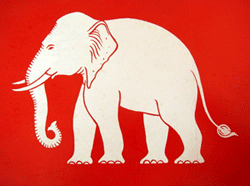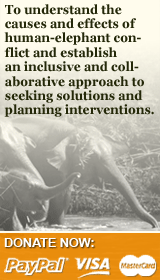ECN History
 |
| The original Thai national flag |
ECN is a small non-government organization that works in partnership with local people and other NGOs as well as local and national government agencies. It was founded in 1998 by Belinda Stewart-Cox and Jittin Ritthirat under the Seub Nakhasathien Foundation (of which Belinda was a founding trustee), but became independent in 1999 when it moved to Kanchanaburi. The idea for an elephant conservation network, along with the ideal of an integrated western forest conservation area, grew out of Belinda's co-authorship of the Thung Yai-Huai Kha Khaeng World Heritage nomination with the late Seub Nakhasathien.
Thailand's largest population of wild elephants depends for its long-term survival on the conservation integrity of the Thung Yai-Huai Kha Khaeng world heritage site but that, in turn, depends for its survival on the conservation integrity of the larger ecosystem that is WEFCOM. Salakpra represents the front-line of human-elephant conflict in WEFCOM, a front-line line that provides the opportunity to seek a sustainable long-term solution to this iconic national problem.
From 1999 to 2001, ECN conducted two background elephant surveys in Thailand's western forest area. The first survey targeted a representative sample of WEFCOM rangers and domestic elephant owners to find out what is known and felt about elephants, elephant conservation and human-elephant conflict in the western forest area and, more particularly, where elephants are most threatened. The answer was Salakpra.
The second more focused survey used semi-structured interviews, focus groups and site visits to get data from guard stations in Salakpra-Tham Thanlod and from villages around the protected area, especially those known to suffer from crop-raiding. This survey identified the need for seasonal surveys inside the protected area and a community-based human-elephant conflict monitoring and mitigation programme. As a result, ECN now focuses on the vulnerable population of elephants and their forest habitat in and around the Salakpra protected area. Since 2005, it has been supported by the Conservation Programme of the Zoological Society of London.





